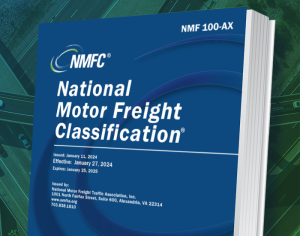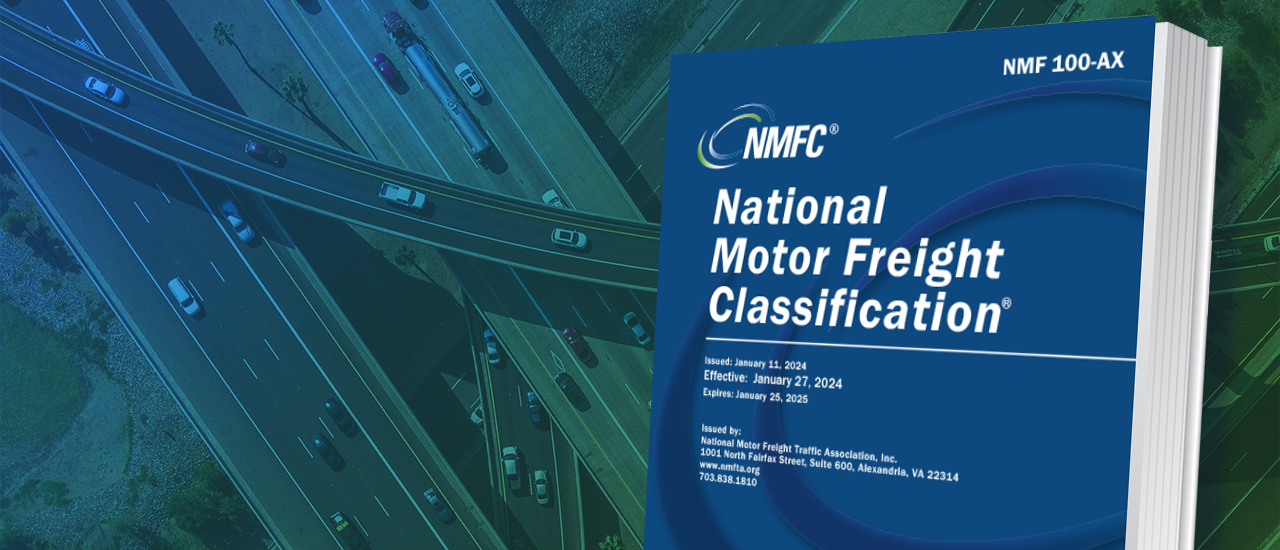- Discover the Future of Freight: Explore how the 2024 NMFC classification updates are set to revolutionize the shipping industry, making freight classification smoother and more intuitive.
- Streamlining for Efficiency: Dive into the “Classification Reimagined” initiative and see how consolidating freight categories can reduce complexity and enhance operational clarity.
- Leveraging Technology in Freight: Learn how advanced tools like ClassIT are being integrated into the NMFC system to ensure precise and easier freight classification.

Updates to the NMFC system aim to simplify the freight classification process.
The Freight Classification Development Council (FCDC) has announced significant NMFC classification updates, set to take effect on May 11, 2024. These updates are designed to simplify the shipping process for commodities across various industries. For a detailed breakdown of how commodities are classified in the freight industry, explore this page.
Understanding the NMFC Classification Updates of 2024
The National Motor Freight Classification (NMFC) system, essential for defining freight classes and streamlining billing and load planning, has undergone substantial updates as announced by the Freight Classification Development Council (FCDC). Set to be effective from May 11, 2024, these changes reflect extensive industry feedback and technological advancements, marking one of the most significant overhauls in recent years. To stay updated on the latest trends and changes within the freight industry, check out this link.
Key Changes in the 2024 NMFC Updates

The ‘Classification Reimagined’ initiative seeks to streamline the NMFC codes.
The 2024 updates, dubbed “Classification Reimagined,” focus on reducing the complexity of the NMFC system by consolidating multiple item numbers and simplifying the overall classification framework. This initiative aims to facilitate a more intuitive and efficient process for shippers and carriers, ensuring that the classification standards are more aligned with modern shipping demands. Discover the latest advancements in logistics technology and how they’re revolutionizing shipping, visit this link.
Enjoying our insights?
Subscribe to our newsletter to keep up with the latest industry trends and developments.
Stay InformedConsolidation and Simplification of Freight Categories
Significant changes include the merging of closely related groups such as the Furniture Group and Furniture Parts Group, as well as the integration of the two Plastic or Rubber Articles groups. This consolidation aims to reduce the number of individual classifications, making the system easier to navigate and apply. By focusing on generic groupings and embracing a more streamlined classification method, the NMFC aims to enhance clarity and compliance across the shipping industry. Learn more about the National Motor Freight Classification system and its impact on freight rates, follow this link.
Impact on Shipping Practices and Industry Compliance

Accurate and efficient classification is now more accessible with digital tools like ClassIT.
The updates also address the practical needs of the shipping industry by modifying the density scale and class assignments to better reflect the transportation characteristics of the commodities. These adjustments are designed to reduce misclassification errors and the subsequent clerical burdens that arise from reclassification, thus optimizing the shipping process and minimizing unexpected fees. Understand the strategies being employed to optimize outcomes in supply chain management, explore this link.
Detailed Overview of Group Changes
Changes to specific groups such as the Foodstuffs Group, Agricultural Implements, and Machinery Group reflect a more generalized approach to item classifications. These changes are expected to reduce the administrative load on shippers and carriers, making it easier to determine the appropriate freight class for a broader range of commodities.
Streamlining for Easier Application
The FCDC’s efforts extend beyond simplification to enhancing the digital interface of the NMFC system. With the transition to the digital-only ClassIT platform in 2024, the NMFC will integrate decision trees and other digital tools to aid users in classifying freight more effectively and accurately.
Future Projections for NMFC Updates

Consolidation of categories is a key aspect of the recent NMFC updates.
Looking forward, the NMFTA plans to continue this trajectory of simplification and digital integration. The ongoing “Classification Reimagined” initiative is set to further refine the classification process, ensuring that the NMFC remains relevant and responsive to the evolving needs of the freight industry. Stay abreast of the latest developments shaping the trucking industry, click here.
Practical Implications for Shippers
For shippers, the new NMFC updates mean a more straightforward classification process, with fewer categories and a reduced risk of misclassification. This can lead to more predictable billing and smoother load planning, ultimately contributing to a more efficient and cost-effective shipping operation. By adhering to these updated guidelines, stakeholders in the shipping industry can anticipate a transition to a more streamlined and user-friendly NMFC system, making it easier than ever to comply with classification standards and focus on core business operations. For additional insights into the regulations affecting shipping and logistics, explore this page.
Additional Insights on Recent NMFC Changes
Recent updates to the NMFC have also focused on specific commodity groups like Fibers, Games and Toys, and Office or Store Equipment, with changes aimed at aligning these classifications with similar commodities. This streamlining effort includes the consolidation of commodity groups like Automotive Covers and Internal Combustion Engines, which simplifies the classification process and reduces the potential for errors (NMFTA).
In their continuous effort to adapt the NMFC to modern needs, the NMFTA has also paid special attention to technological advancements such as the increased use of dimensioners by carriers. These devices, which help accurately capture the density and dimensions of freight, have become a crucial factor in the FCDC’s strategy to refine the classification process (NMFTA).
The updates are a response to both stakeholder feedback and an internal review by the NMFTA, reflecting the dynamic nature of the shipping and freight industry. As these updates take effect, they are expected to enhance the usability of the NMFC for both new and seasoned shippers, ensuring that the classification system remains a reliable and essential tool for the freight industry (NMFTA).
Key Developments in NMFC Classification Updates
- Consolidation of Categories: Significant changes in the NMFC system include the merging of groups like Furniture and Furniture Parts, as well as Plastic or Rubber Articles, aimed at simplifying the classification process for shippers and carriers.
- Introduction of General Categories: The update introduces broader categories, encompassing a wider range of products, which helps in reducing the administrative burden and potential for classification errors.
- Enhanced Digital Tools: The transition to the digital-only ClassIT platform marks a pivotal development, incorporating decision trees and other features to streamline the classification process and ensure compliance with modern shipping requirements.
- Focus on Technological Integration: The increased use of dimensioners and other technological advancements are being integrated to capture accurate freight data, enhancing the accuracy and reliability of the NMFC system.
National Motor Freight Classification (NMFC) –18 Classes of Categorized Freight
The National Motor Freight Classification (NMFC) system categorizes freight into 18 classes, ranging from Class 50 to Class 500, based on four key transportation characteristics: density, stowability, handling, and liability. The NMFC codes are essential for determining the correct freight class, which directly influences shipping costs and ensures that shippers pay a fair price for the transportation services they receive.
Here’s a general breakdown of how commodities are classified within the NMFC system:
- Class 50 to Class 55: These are typically items like bricks, cement, and hardwood flooring, which are dense and not easily damaged.
- Class 60 to Class 65: This range includes items such as car parts and bottled beverages.
- Class 70 to Class 85: Classes here generally cover newspapers, wooden pencils, unassembled furniture, and crated machinery.
- Class 92.5 to Class 100: Includes more delicate items like computers, monitors, and wine cases.
- Class 110 to Class 125: Features items like small household appliances and exhibit booths.
- Class 150 to Class 175: This range includes ATVs, jet skis, and clothing.
- Class 200 to Class 250: Includes TVs, aircraft parts, and unassembled furniture.
- Class 300 to Class 400: These classes cover less dense items like wooden furniture and decorative articles.
- Class 500: The highest class, reserved for very low-density or high-value items like ping pong balls or bags of gold dust.
Each specific NMFC code within these classes is assigned based on the density, handling, stowability, and liability associated with shipping the commodity. It’s important to use the most current NMFC codes as they can change quarterly, and using outdated codes can lead to misclassification and higher costs.
For detailed listings and updates, the NMFC provides tools and resources through platforms like ClassIT, which can be accessed for the most accurate and up-to-date classification information. Here’s the link to the ClassIT platform for detailed NMFC lookups and further information: ClassIT.
These classifications and codes are crucial for shipping efficiently and cost-effectively, ensuring that goods are handled properly based on their specific needs and characteristics.
Explore External Insights on Freight Classification and NMFC Updates
- Official NMFC Standards and Updates: Learn more about the NMFC system’s official standards and recent updates at NMFTA Official Site.
- Classification Reimagined Initiative: For detailed insights into the NMFC’s recent “Classification Reimagined” initiative, visit Classification Reimagined at NMFTA.
- Understanding Freight Classifications: Understand the regulations and laws in freight classification at Commodity Description and Freight Classification at eCFR.
- NMFC Code Lookup Tool: For a comprehensive NMFC code lookup tool to classify your freight accurately, check out ClassIT by NMFTA.
- Upcoming NMFC Standards Discussion: Stay updated on the latest discussions about NMFC standards by visiting Upcoming NMFC Meetings at NMFTA.





















